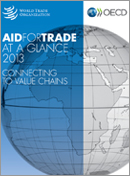G20 › Topics › Development › Aid for Trade at a Glance: Connecting to Value Chains
Aid for Trade at a Glance: Connecting to Value Chains
The publication Aid for Trade at a Glance: Connecting to Value Chains was launched at the 4th Global Review of Aid for Trade at WTO on 8-10 July 2013.
Read the remarks by OECD Secretary General Angel Gurría to the Global Review.
|
Publication date: ISBN: 9789264201026 (print) |
This joint OECD-WTO publication puts a spotlight on aid for trade to assess what is happening, what is not, and where improvements are needed. The analysis is focused on trends in aid-for-trade policies, programmes and practices. It shows that the Aid-for-Trade Initiative is delivering tangible results in improving trade performance and bettering people’s lives, notably those of women, in developing countries. The report highlights that aid for trade plays an important role in enabling firms in developing countries to connect with or move up value chains. In fact, the emergence of value chains strengthens the rationale for aid for trade. Stakeholders remain actively engaged in the Aid-for-Trade Initiative. The 2013 monitoring exercise was based on selfassessments from 80 developing countries, 28 bilateral donors, 15 multilateral donors, and 9 providers of South-South co-operation. Views were also received from 524 supplier firms in developing countries and 173 lead firms, mostly in OECD countries. Consult the Self Assessments and Factsheets related to the 4th Global Review of Aid for Trade. Listen to a short interview with aid-for-trade expert, Frans Lammersen. |
|
Table of Contents |
Chapter 1. Is aid for trade adapting to new realities?
This chapter discusses how the evolving trade and development context is shaping aid for trade. It illustrates how partner countries, donors and providers of South-South trade-related co-operation are using aid for trade to assist developing countries to enter (and establish their own) value chains.
Chapter 2. Aid-for-trade flows and financing
This chapter provides a comprehensive overview of aid-for-trade flows, ODA commitments and disbursements, trade-related Other Official Flows (OOF ) and South-South trade-related co-operation. It examines aid-for-trade flows using data from the OECD Creditor Reporting System (CRS ), complemented by findings from the OECD / WTO monitoring survey. It examines recipients and providers of assistance, the financial terms of assistance, and the outlook for aid for trade.
Chapter 3. Value chains and the development path
This chapter addresses how value chains offer a path to economic development. Based on the findings from the 2013 OECD / WTO survey, it assesses the resonance that value chains have in the aid-for-trade priorities and strategies of partner countries, bilateral and multilateral donors, and providers of South-South trade-related co-operation. The analysis in this chapter of the agri-food, ICT, textiles and apparel, tourism, and transport and logistics value chains highlights that developing country suppliers are integral to these value chains – and that developing countries use their participation to achieve growth, employment and poverty reduction objectives. (Read the Aid for Trade Value Chains Sector Studies)
Chapter 4. Boosting value chains via regional aid for trade
This chapter shows that regional aid for trade has a critical role to play in boosting the participation of particularly low income and least developed countries in regional production networks, and in enabling them to connect and move-up value chains. It highlights that one of the main motivations of the trend towards regional integration is the need to reduce barriers in regional production networks.
Chapter 5. Evaluating the effectiveness of aid for trade
This chapter explores the effectiveness of aid for trade in promoting trade – both exports and imports – and conditions which tend to make it most effective. The review provides abundant evidence to suggest that aid for trade is indeed broadly correlated with increases in trade. Aid for trade works best when it is focused on reducing the costs of trading through improvements in infrastructure, trade facilitation, trade-related public institutions.
Chapter 6. The way forward
This chapter summarises the main developments in aid for trade since the 2011 Global Review. Based on the findings of the OECD /WTO monitoring survey, the analysis of aid-for-trade flows, and conclusions in the broader trade and development literature, it appears that the proliferation and deepening of value chains and the concomitant widening of trade opportunities for developing countries do not require major shifts in the focus of aid-for-trade efforts. Nevertheless, there is room for improvement, such as further engaging providers of South-South trade-related co-operation and the private sector, expanding the focus from ODA to development finance, improving the conditions for regional projects, and better managing aid for trade and development results.
Aid-for-trade country fact sheets
Annex A. Aid-for-trade key data
Annex B. DAC list of ODA recipients by income group
Annex C. DAC list of ODA recipients by region
Annex D. Aid-for-trade related CRS purpose codes by category
Annex E. Regression estimates
Annex F. Methodology for econometric analysis
Related Documents



Follow us
E-mail Alerts Blogs